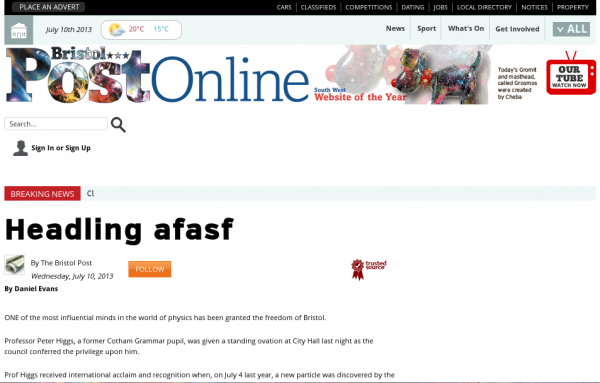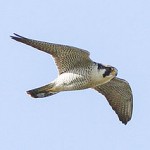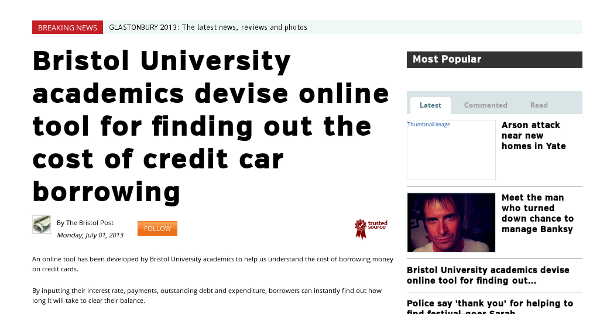Bristol Post Balls 3 – everyday sexism
The Bristol Post’s gaffes are not restricted to its website and dead tree version.
Yesterday its Twitter feed yielded the following bit of everyday sexism (and no apology when challenged. Ed.).

The Bristol Post’s gaffes are not restricted to its website and dead tree version.
Yesterday its Twitter feed yielded the following bit of everyday sexism (and no apology when challenged. Ed.).

The other afternoon I was having a rare afternoon pint in the shady garden of The Volunteer Tavern in St Judes when mine host Peter Gibbs asked me a question along the lines of: “What are these small brown birds I keep seeing in the garden?”
I told him that I’d frequently seen (and heard; as the RSPB remarks, “For such a small bird it has a remarkably loud voice.” Ed.) wrens in the garden.

The wren is Britain’s smallest bird, measuring 9.5-10 cm, and used to feature on the back of Britain’s smallest coin – the pre-decimal farthing, which ceased to be legal tender after 31st December 1960.

Despite its small size, the wren has a big binomial name: Troglodytes troglodytes.
The wren is found across the UK in a wide range of habitats – woodland, farmland, heathland, moorland and islands and is a regular visitor to gardens, including pub gardens in central Bristol. 🙂
In European folklore, the wren is named the King of the Birds. According to a fable attributed to Aesop by Plutarch, when the eagle and the wren strove to fly the highest (presumably for the title of King of the Birds. Ed.), the wren initially rested on the eagle’s back and then when the eagle tired, the wren took off from his back, soared above him and so won the accolade.
Below is a screenshot of the story in today’s Bristol Post reporting on Professor Peter Higgs – one of the team that postulated the existence of the particle named after him back in the 1960s – being granted the freedom of the city of Bristol.

Professor Higgs is a former pupil of Bristol’s Cotham Grammar School.
For a local media report of the event that has a proper headline, I recommend Bristol 24/7’s offering.
Bristol & Avon Family History Society has some interest background information on the history of the Freedom of Bristol and Burgesses, as Freemen (and they were men in medieval times. Ed.) were originally known.
“What’s that Gromit, people have been visiting Lawrence Hill to see you in your Lodekka livery, looking like an old-style Bristol Bus Company bus in British racing green?”

“Cracking!”
Here in BS5, we’re very pleased to have one of the Gromit sculptures placed around the city as part of Gromit Unleashed – a public art exhibition in which giant sculptures of Gromit, decorated by invited artists, have been unleashed on the streets of Bristol and the surrounding area.
At the end of the art trail, the sculptures will be auctioned to raise funds for Wallace & Gromit’s Grand Appeal, the Bristol Children’s Hospital charity.
It’s always a good idea to keep one’s ears open walking around the city – or anywhere for that matter.
Yesterday lunchtime when crossing St Philips Bridge (below) my ears heard a real treat – a peregrine falcon in the heart of Bristol.


I’ve seen peregrines before near Bristol, particularly down the Avon Gorge, where I’ve spotted them nesting in the Gorge’s old quarries, but never before in the heart of the city.
Naturally, I was quite excited by this and asked Bristol’s Twitter users how unusual this was. After a couple of hours, I received a reply from naturalist and broadcaster Ed Drewitt, who informed me there was a “family of 3 chicks around Cabot Circus way” (they might help keep the city centre’s gull and feral pigeon population under control. Ed.).
Around my home patch of Easton I have over the years seen both sparrowhawks and kestrels, whilst moving further afield the patchwork of open grassland and woodland on Purdown and Stoke Park is ideal buzzard territory.
Finally, there’s one bird of prey I believe I’d heard that I’d really love someone else to corroborate. Returning home some years ago, I could have sworn I heard a tawny owl hooting in the vicinity of the railway embankment between Stapleton Road and Lawrence Hill railway stations. If anyone else has heard hooting there too, I’ll know I wasn’t imagining things. 🙂
Spot the typographical error in the headline below from today’s online edition of the Bristol Post.

Never having had children, my contact with local play facilities has been limited. However, I do remember having a lovely conversation about the history of Bristol’s Easton district with the late local historian Lionel Ellery a couple of decades ago at Felix Road Adventure Playground.
The adventure playground itself is sited on what was once the north coalyard of Easton Colliery, which operated from 1824 until 1911. From 1913 to 1972 the adventure playground then site served as a stone yard for Bristol building firm Cowlin.
Felix Road Adventure Playground was established in 1972 by a group of local parents concerned that their children should have a space to play.
However, its future is now under threat due to funding cuts by Bristol City Council, meaning it can only open for 2 days a week.
A petition has been organised to secure the playground’s future. You can sign it online here.
Paper versions of the petition have been left at these places for signature:

The petition needs 3,500 signatures to trigger a debate of the matter in full council.
What is particularly galling about this funding cut is that Felix Road is located in Bristol’s Lawrence Hill ward, reputedly the most deprived council ward in South West England.
Meanwhile, play facilities in some more prosperous parts of the city are not having their funding cut to the same extent.
It is believed that St Paul’s Adventure Playground in St Agnes – an area with similar deprivation to Felix Road – is also under the same threat due to funding cuts.
Why are Bristol’s poorest districts always treated so badly?
It’s almost as if the city’s great and good couldn’t care less about those not so fortunate as themselves.
The phrase “to spend a penny”, meaning to use a public lavatory, has its origins in the use of coin-operated locks on public toilets in the UK. When these were first introduced, the fee for use was normally one penny (1d); and it stayed at that level for decades, well into the second half of the twentieth century.
However, the cost of being caught short and having to use a public lavatory has undergone a massive inflationary rise if a report in today’s Bristol Post is to be believed.

Pictured above is an old English bank note with a face value of 10 shillings; that’s equivalent to 240 pence.
The Bristol Post report states that people could be charged up to 50p (that’s ten shillings in old money. Ed.) to spend a penny in a new block of town centre toilets in Portishead, which could cost up to £40,000 to build.
The Post quotes Portishead Town Council Clerk Jo Duffy as follows on the likely cost of spending a penny:
There would be a charge levied for using the toilets, which could be up to 50 pence per visit. However the town council is keen to keep the charge at a lower level of around 20 pence if possible.
Even 20 pence for a pee is extortionate, in my opinion.
This blog has covered the peculiarities of life in North Somerset before now (posts passim) and at least one person leaving a comment on the Post report feels relieved he’s not a resident:
Every day I wake up and thank the Lord that I don’t live in North Somerset.
Yesterday’s Bristol Post reports that the CWS silos in Avonmouth (affectionately known locally as ‘The Mouth’. Ed.) are curently being demolished.
The silos are shown in the full glory in happier times. The older one on the left was built in the 1920s and is one of the few industrial buildings in Bristol with Art Deco features. The younger silo on the right was built in the 1950s. They used to supply mills on the same site; the mills themselves were demolished some 30 years ago.

In my opinion, the 1920s silo was worthy of listing as a building of architectural or historic interest for its Art Deco style. What a pity it wasn’t. 🙁
The Mayflower is a steam tug preserved by Bristol Museums Galleries & Archives. She is based in the City Docks outside the M Shed. She is the oldest Bristol-built ship still afloat and is believed to be the oldest surviving tug in the world.
She was launched on 18th May 1861, cost £1,000 and was built to work on the Gloucester and Sharpness Canal and the River Severn.
This week she’s not afloat at all, but high and dry on the patent slipway of the Underfall Yard undergoing some maintenance and is due to remain there for the next week, as I gathered on Friday evening.
